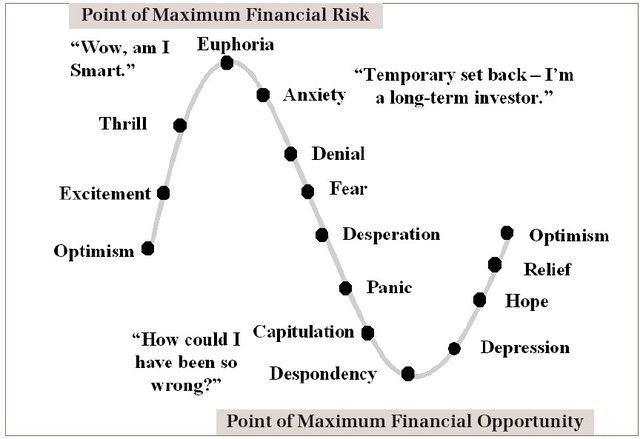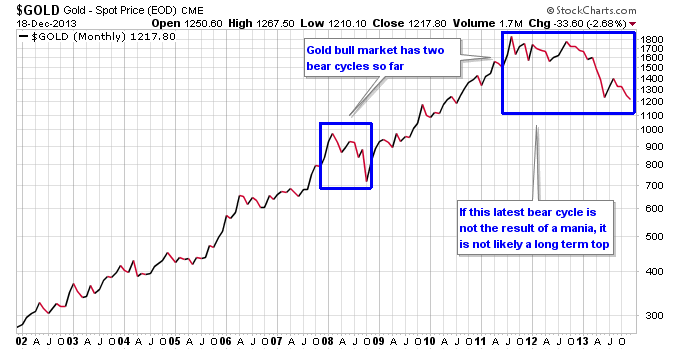REFUELING A BULL MARKET
All markets go through cycles. Secular or long term bull markets are often interrupted by cyclical or short term bear markets. These short term bear markets often feel like they will never end, but they serve to refuel the bull market. The reason is bull markets are powered by new buyers. Any market that goes up too far, too fast, runs out of new buyers, and thus becomes more vulnerable as buyers are exhausted. Everyone gets excited that the market is going to the moon. But in reality too much buying has been pulled forward in time because too many people rushed in at the top. This is how markets fake out the majority of participants at the extremes. Too many people do the wrong thing at the top, leaving not enough people to keep the market going higher. The balance of power shifts to the sellers, which drives the market back down.
The chart below depicts this cycle and shows how the majority is wrong at the extremes. At the top is euphoria, where extreme buying fakes out the majority of market participants and produces a market top. Extreme buying feels good at the top, but counter-intuitively it is also what produces bear markets. Once the buyers are finally overwhelmed, sellers take control, and the market works through the bear market cycle.
After a period where anxiety turns to fear and panic, the bear cycle usually ends in capitulation, or extreme selling. At that point selling is actually pulled forward in time, sellers that would have sold in the future are suddenly flushed out of the market. But only brave buyers are stepping in to the market at this point, just enough of them to outweigh the sellers and produce a bottom. The fear at the bottom takes a while to dissipate, which is what produces the despondency and depression that really puts the floor in. The market puts in this floor or basing phase where just enough buying is keeping pace with selling, and then all of a sudden new buyers come back into the market. And wholla, the bull market cycle starts again as new buyers overwhelm the sellers.
Long term bull markets tend to go through this cycle multiple times before they eventually top. Think about what happened in the 1980 to 2000 stock bull market. Bear market cycles reset investor sentiment in 1987, 1990, 1994, and as late as 1998. These bear markets were just natural parts of the overall long term cycle. Resetting sentiment, refueling the bull market.
Now long term bull markets don’t usually top until they go into a mania. This is exactly what happened in the stock bull market when it ended. In a mania buying is so extreme it pulls forward future buying for years and even decades. The buying is so out of control once it dries up prices actually drift sideways in a long term sense. In the short term though it’s just another bear cycle and usually a vicious one after a mania. This explains why after the mania in 2000, we got a new bull market in stocks as early as 2003. But stocks still haven’t made significant progress over the 2000 high 13 years later.
If you look at gold, it’s had two bear market cycles now, one in 2008 and one from 2011 to 2013. A good argument could be made that gold did not go into a mania in 2011 either. The hallmarks of a mania, over-ownership, over-supply, and excessive sentiment just weren’t present in 2011 for gold. Therefore once the sellers and buyers reach equilibrium in gold which is getting closer by the day, all it should take is new buying to reignite the gold bull market.
Connect with me on Twitter: @nextbigtrade
The original article and much more can be found at: http://www.nextbigtrade.com
The views and opinions expressed are for informational purposes only, and should not be considered as investment advice. Please see the disclaimer.







